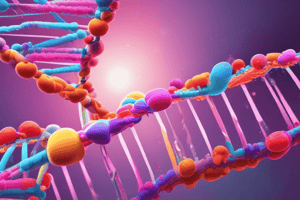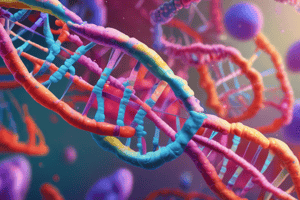Podcast
Questions and Answers
What is the role of the centromere in a chromosome?
What is the role of the centromere in a chromosome?
- It contains non-coding DNA sequences.
- It helps in protein synthesis.
- It is where the DNA is stored.
- It is the region where sister chromatids are joined. (correct)
Homologous chromosomes are identical copies of a chromosome.
Homologous chromosomes are identical copies of a chromosome.
False (B)
What replaces thymine in RNA?
What replaces thymine in RNA?
Uracil
The process of DNA being transcribed into mRNA occurs during ______.
The process of DNA being transcribed into mRNA occurs during ______.
Match the types of RNA with their primary function:
Match the types of RNA with their primary function:
What is a point mutation?
What is a point mutation?
Polyploidy is having only two sets of chromosomes.
Polyploidy is having only two sets of chromosomes.
What does the Central Dogma describe?
What does the Central Dogma describe?
What type of cells undergo meiosis to produce haploid cells?
What type of cells undergo meiosis to produce haploid cells?
Humans have 46 chromosomes in their germ cells.
Humans have 46 chromosomes in their germ cells.
What is the structure made of DNA and proteins that carries genetic information?
What is the structure made of DNA and proteins that carries genetic information?
A segment of DNA that codes for a specific protein is known as a ___.
A segment of DNA that codes for a specific protein is known as a ___.
Match the following terms with their definitions:
Match the following terms with their definitions:
Which nitrogenous base pairs specifically with Adenine?
Which nitrogenous base pairs specifically with Adenine?
DNA is made up of amino acids.
DNA is made up of amino acids.
What is the primary role of histone proteins in the cell?
What is the primary role of histone proteins in the cell?
Flashcards
Somatic Cells
Somatic Cells
Body cells that make up most of an organism. These cells are diploid, containing two sets of chromosomes (one from each parent).
Germ Cells
Germ Cells
Reproductive cells that develop into gametes (sperm and eggs). They undergo meiosis to produce haploid cells.
Gametes (Sex Cells)
Gametes (Sex Cells)
Haploid cells (sperm in males, eggs in females) containing one set of chromosomes. They fuse during fertilization to form a zygote.
Diploid Nucleus
Diploid Nucleus
Signup and view all the flashcards
Zygote
Zygote
Signup and view all the flashcards
Chromosome
Chromosome
Signup and view all the flashcards
DNA (Deoxyribonucleic Acid)
DNA (Deoxyribonucleic Acid)
Signup and view all the flashcards
Gene
Gene
Signup and view all the flashcards
Centromere
Centromere
Signup and view all the flashcards
Non-coding DNA
Non-coding DNA
Signup and view all the flashcards
Sister Chromatids
Sister Chromatids
Signup and view all the flashcards
Homologous Chromosomes
Homologous Chromosomes
Signup and view all the flashcards
DNA Structure
DNA Structure
Signup and view all the flashcards
RNA (Ribonucleic Acid)
RNA (Ribonucleic Acid)
Signup and view all the flashcards
Nitrogenous Bases
Nitrogenous Bases
Signup and view all the flashcards
Central Dogma
Central Dogma
Signup and view all the flashcards
Study Notes
DNA Structure and Function
- DNA is a double helix comprised of a sugar-phosphate backbone and nitrogenous bases.
- The backbone consists of alternating deoxyribose sugar and phosphate molecules.
- The rungs of the ladder are nitrogenous bases: adenine (A) with thymine (T), and cytosine (C) with guanine (G).
- DNA contains the instructions (genes) for building and operating an organism.
- Human cells possess approximately 120,000 genes, with roughly 40,000 actively used to create the organism's traits.
- The remaining 80,000 genes are currently deemed inactive.
Genes and Alleles
- A gene is a segment of DNA that codes for a specific protein.
- Alleles are variants of a gene, leading to variations in traits like eye color.
- Genotype refers to the set of alleles an organism possesses.
- Phenotype is the observable expression of traits, influenced by both genotype and environment.
- Homozygous dominant genotype contains two dominant alleles (e.g., AA).
- Homozygous recessive genotype possesses two recessive alleles (e.g., aa).
- Heterozygous genotype has one dominant and one recessive allele (e.g., Aa).
Cell Types and Reproduction
- Somatic cells form the body, diploid (2n) with two sets of chromosomes (one from each parent).
- Germ cells, which develop into gametes (sperm and egg), are also diploid but undergo meiosis to form haploid gametes (n).
- Gametes are haploid, with only one set of chromosomes.
- Fertilization of gametes produces a zygote, a single diploid cell.
- Heredity is the transmission of traits from parents to offspring via reproduction.
Chromosomes
- Chromosomes are structures made of DNA and proteins that carry genetic information; humans have 46 chromosomes.
- Sister chromatids are identical copies of a chromosome bound at the centromere.
- Homologous chromosomes are pairs of chromosomes (one from each parent) with genes for the same traits.
Nucleic Acids
- RNA is a single-stranded molecule that plays a central role in protein synthesis.
- RNA differs from DNA by using uracil (U) in place of thymine (T).
- The three major chemical groups within DNA are the sugar deoxyribose, the phosphate group, and the nitrogenous bases.
Protein Synthesis and the Central Dogma
- The central dogma outlines the flow of genetic information: DNA → RNA → protein.
- Transcription copies DNA's genetic code onto mRNA.
- Translation uses the mRNA code to assemble proteins at ribosomes.
- tRNA brings amino acids to the ribosome during protein synthesis, guided by mRNA.
- rRNA is part of the ribosome structure, catalyzing protein synthesis.
Other Important Concepts to Know
- Nondisjunction: Improper chromosome separation during meiosis, leading to aneuploidy (abnormal chromosome number).
- Trisomy is the presence of an extra chromosome, and monosomy the deficiency of one.
- Mutations include point mutations (alterations in single nucleotides) and chromosomal deletions.
- Polyploidy involves having more than two sets of chromosomes, common in plants.
- Meiosis is the type of cell division that produces four haploid gametes.
- Spermatogenesis is the process of sperm formation in males, and oogenesis is the process of egg formation in females.
- Histone proteins are responsible for packaging DNA in the nucleus.
- Non-coding DNA plays a role in cellular processes like gene regulation and structure.
- Epigenetics studies how environmental factors affect gene expression without altering the DNA sequence.
- A Karyotype is a visual representation of an organism's chromosomes, useful in detecting chromosomal abnormalities.
- Autosomes are non-sex chromosomes; humans have 22 pairs.
Studying That Suits You
Use AI to generate personalized quizzes and flashcards to suit your learning preferences.




